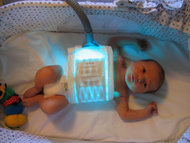Hyperbilirubinemia
Jaundice, also known as icterus (adjective:"Icteric"), is yellowing of the skin, sclera (the white of the eyes) and mucous membranes caused by increased levels of bilirubin in the human body. Usually the concentration of bilirubin in the blood must exceed 2–3mg/dL for the coloration to be easily visible. Jaundice comes from the French word jaune, meaning yellow. more...
Causes of jaundice
When red blood cells die, the heme in their hemoglobin is converted to bilirubin in the spleen and in the kupffer cells in the liver. The bilirubin is processed by the liver, enters bile and is eventually excreted through feaces.
Consequently, there are three different classes of causes for jaundice. Pre-hepatic or hemolytic causes, where too many red blood cells are broken down, hepatic causes where the processing of bilirubin in the liver does not function correctly, and post-hepatic or extrahepatic causes, where the removal of bile is disturbed.
Pre-hepatic
Pre-hepatic (or hemolytic) jaundice is caused by anything which causes an increased rate of hemolysis (breakdown of red blood cells). In tropical countries, malaria can cause jaundice in this manner. Certain genetic diseases, such as glucose 6-phosphate dehydrogenase deficiency can lead to increase red cell lysis and therefore hemolytic jaundice. Defects in bilirubin metabolism also present as jaundice. Jaundice usually comes with high fevers.
Hepatic
Hepatic causes include acute hepatitis, hepatotoxicity and alcoholic liver disease. Less common causes include primary biliary cirrhosis, Gilbert's syndrome and metastatic carcinoma. Jaundice commonly seen in the newborn baby is another example of hepatic jaundice.
Post-hepatic
Post-hepatic (or obstructive) jaundice, also called cholestasis, is caused by an interruption to the drainage of bile in the biliary system. The most common causes are gallstones in the common bile duct and pancreatic cancer in the head of the pancreas. Other causes include strictures of the common bile duct, ductal carcinoma, pancreatitis and pancreatic pseudocysts. A rare cause of obstructive jaundice is Mirizzi's syndrome.
The presence of pale stools suggests an obstructive or post-hepatic cause as normal feces get their colour from bile pigments.
Neonatal jaundice
Neonatal jaundice is usually harmless: this condition is often seen in infants around the second day after birth, lasting till day 8 in normal births, or to around day 14 in premature births. Serum bilirubin normally drops to a low level without any intervention required: the jaundice is presumably a consequence of metabolic and physiological adjustments after birth. Infants with neonatal jaundice are often treated with bili lights, exposing them to high levels of colored light to break down the bilirubin. This works due to a photo oxidation process occurring on the bilirubin in the subcutaneous tissues of the neonate. Light energy creates isomerization of the bilirubin and consequently transformation into compounds that the new born can excrete via urine and stools. Blue light is typically used for this purpose. Green light is more effective at breaking down bilirubin, but is not commonly used because it makes the babies appear sickly, which is disturbing to observers.
Read more at Wikipedia.org



